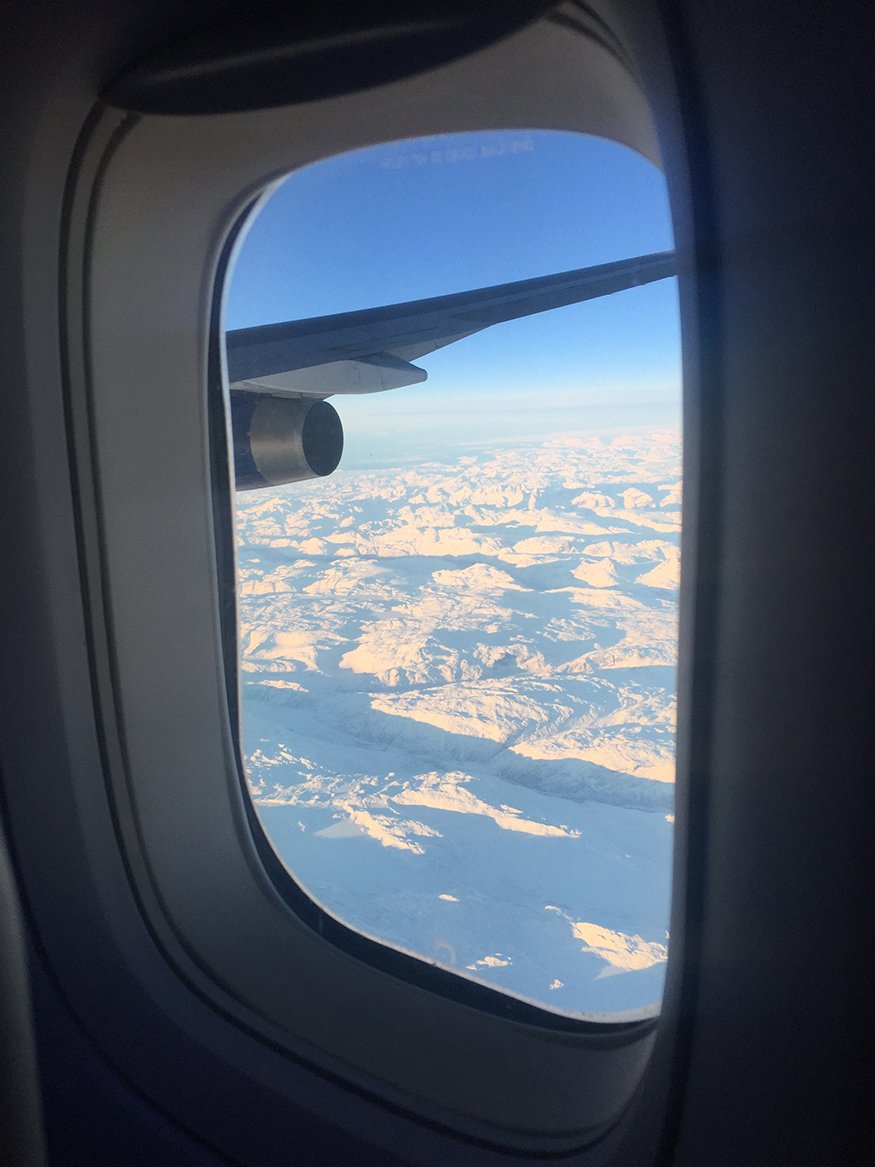Architects Marc & Nada Breitman | Daniel Andries Travel Journal
Daniel Andries Travel Journal
Architects Marc & Nada Breitman: Talk of the Town is the third documentary about the recipient of Richard H. Driehaus Prize at the University of Notre Dame that we’ve made in Europe. In 2013, we traveled to Italy for Architect Pier Carlo Bontempi: A Taste for the Past and in 2017, we were in the UK for Architect Robert Adam: A Place at the Table. This year, our architects live and work in Paris. I took French classes in high school, so it might be assumed that I could follow a bit of what was being said. I could a bit – “un peu,” as the French say. For the sake of full transparency, I will let you be the judge of my skill level. Below is a 100% real list – made while eating dinner alone in a restaurant on the outskirts of Paris – of French words that I could understand as I heard them.
Jamais (never)
Derniers (last)
Mystérieux (mysterious)
Oui (yes)
L’addition (the check)
Très jolie (beautiful)
Premier (first)
Ç’est ça! (That’s it!)
Changement (change)
Pas mal (not bad)
Troisième (third)
Un peu (a little)
Petit (small)
There is a distinct lack of verbs in my list. Pronouns, too. My apologies to the Deerfield High School French Department, and my teacher, Mrs. Layna Szabo.
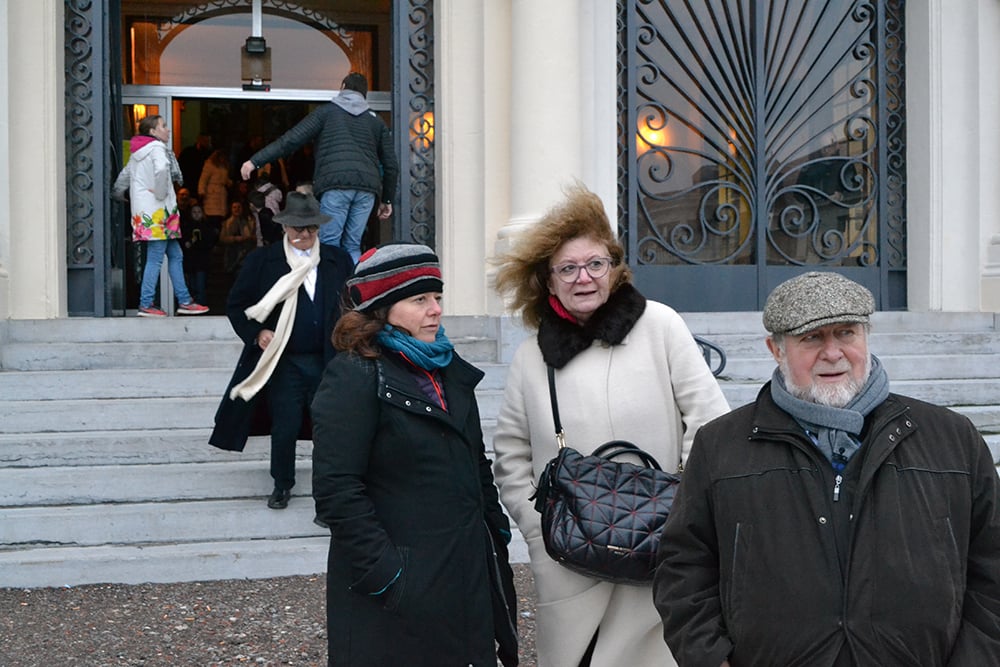
On the River
We have a saying in our little unit: “we’re on the river.” Imagine you’re in a canoe or kayak headed downstream, and sometimes there are rapids, sometimes the sun pounds down and there is no current and no shade, sometimes you capsize. You’re on the river, and you just have to go with the flow. That’s what making these shows is like. Planning only goes so far, and then you’re on the river. This picture captures a fairly typical moment of being on the river with our subjects, Marc Breitman and his wife and partner Nada Breitman-Jakov. We are in Liévin in northern France, on the steps of the Town Hall, or the Hôtel de Ville, as the French call it. We were there with the Breitmans to interview Jean-Pierre Kucheida, the bearded man on the right of the photo. Marc’s marvelous outfit is visible – the long overcoat, the scarf, the hat, the hair, the glasses. All simple elements that create a sense of iconic presentation. The wind blows, the hour is late, the group is laid out casually across the steps of the building. By this point we have gotten better at ensuring that lunches don’t last two hours, in knowing that our hotels need to have ramps for our camera equipment, in making sure we have an experienced driver/fixer with us. And, that we are ready for interview subjects like Mr. Kucheida, who do not speak English. Co-producer Liz Reeves talks with Nada as we rush to finish our photography so that the wedding party inside the Hôtel de Ville can use the steps for their celebratory photo.
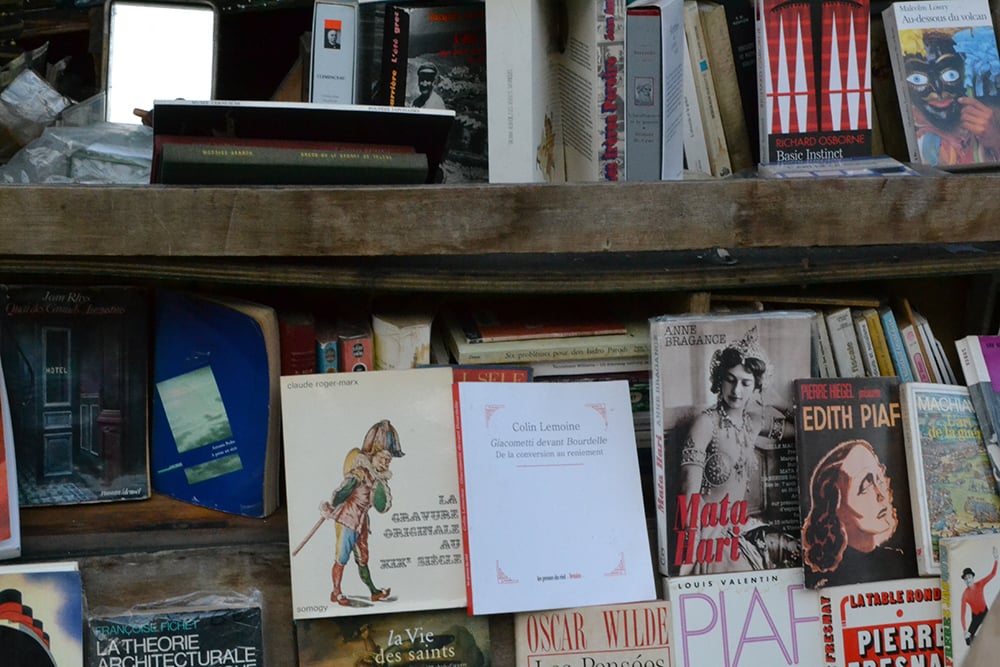
Bouquinistes
Our documentary spends time in a UNESCO World Heritage Site – the Nord-Pas-de-Calais Mining Basin, recognized for its role fuelling France’s industrial power in the eighteenth, nineteenth, and twentieth centuries. Here is another UNESCO World Heritage Site – the booksellers’ stalls that line Paris’s Left Bank. According to something I just read on the web, they’ve been there in one form or another since the sixteenth century. Called Bouquinistes, they stretch for blocks along the River Seine not far from Notre Dame, and a short walk from the Breitmans’ home and office. On our one free afternoon, I spent a little time checking out what they had to offer. This photo is an arbitrary framing of arbitrary contents. My contention is that any of the stands could have yielded an equally juicy collage of names, faces, and languages, a joy for someone who loves books and reading as much as I do. Mata Hari looks away from Edith Piaf. The French translation of Malcolm Lowry’s drunken journey to the grave on the Mexican Day of the Dead, Under the Volcano, rests near the novelization of the Michael Douglas-Sharon Stone erotic thriller Basic Instinct, its dubious content hidden behind a jacket of non-committal abstraction. Titles by Jean Rhys, Tennessee Williams, Oscar Wilde, Federico García Lorca. Something about Giacometti. And at the bottom of the picture on the left, a book of architectural theory next to the lives of the saints. It’s a world of its own.
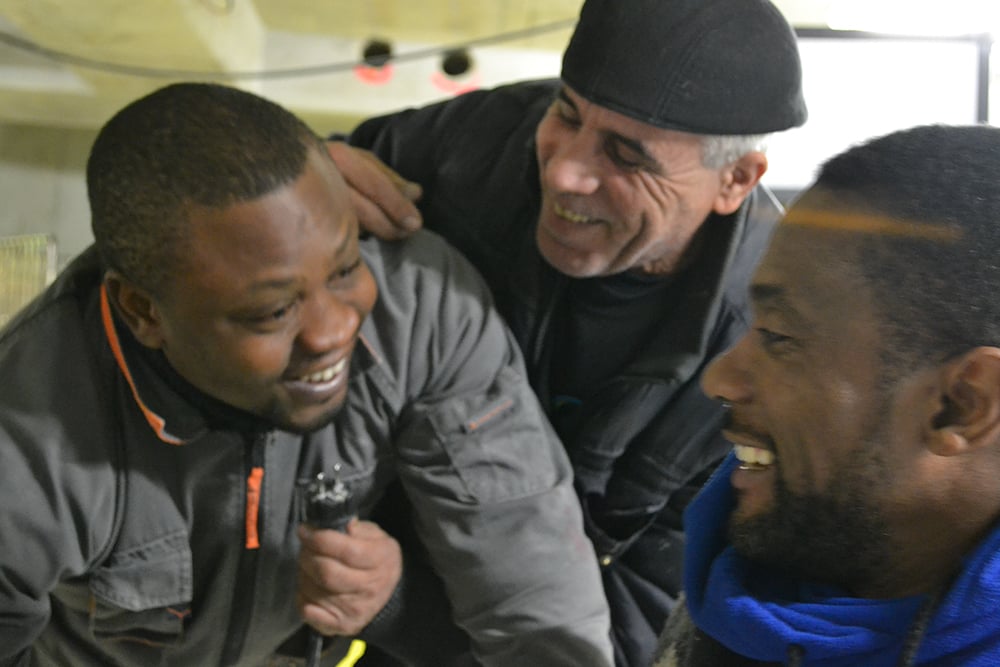
The Construction Workers
Our first day of shooting found us documenting a meal celebrating the completion of one phase of construction on a building designed by the Breitmans. The meal is shared with the developers and the workers. The cooking and serving of gigot bitume, or lamb cooked in boiling tar (yes, that’s right) opens the documentary. Once the photography was done, I sat down and joined everyone at one of the beautifully set tables in the building’s basement-level concrete garage. Across from me were a group of workers from North Africa. The man in the middle was gregarious and jokey, constantly trying to engage us in some side comment or jest. Here I think he’s parodying a TV interview, holding the plug like a microphone at the mouth of his compatriot. I liked his energy and the cut of his jib, as they say, even if I didn’t understand much, if any, of what he was saying. Someone told me he was Algerian. The other two were from Morocco.
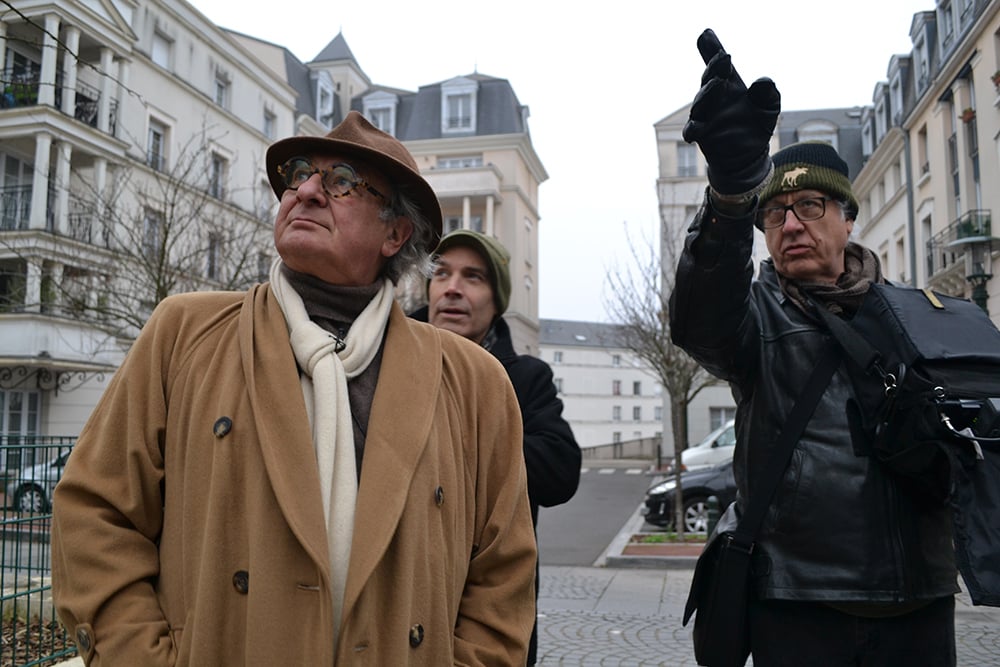
Directing
I once read an interview with a famous Hollywood director, don’t remember who, who said that all photos of directors working featured them pointing. He explained that apparently that’s how you knew they were the director. Because they were pointing. Here I am pointing. Directing a documentary like this involves quickly assessing locations you’ve never been in before, identifying details you hope might prove narratively valuable, and arranging your subjects in the landscape in a way that will work for the piece that you’re still making up as you go along. This piece, like only a few before, was an improvisation. Detailed planning with the Breitmans was fruitless: Marc would arrive alone when we thought Nada would be with him, or they’d tell us they weren’t driving north to coal country but taking the train. We had to go with it. I trusted the basic course and didn’t fret about it too much, believing geography, biography, and the charm of French people talking would guide us home. Here I’m pointing so that Marc and Geoffrey understand that I want Marc to point out the challenge a casual observer would have in distinguishing the difference between subsidized and market-rate housing in Le Plessis-Robinson. You can see the shot in the first five minutes of the finished documentary.
Our Imaginary Assistant Director
The assistant director, or the a.d., is a person who, in traditional Hollywood filmmaking, arranges the background action. We don’t have assistant directors in our work, but cameraman Tim Boyd and I work with an imaginary a.d. He even has a name (yes it’s a he). But for now he shall remain publicly anonymous in an attempt to respect the magic of what he achieves for us. Here is a terrific example of his craft at its best. This is the entrance to the parking garage in Chaville, an underground cavern that Marc Breitman told us was an engineering marvel – think of how Millennium Park is built atop a parking garage. We didn’t end up talking about the garage in the finished show – it was cut for time early on in the process. But watch this shot. For those who just see cars coming in and out of a hole in the wall, allow me to narrate. A car sits at the top of a ramp. A woman with a stroller enters from the left. A second car goes up the ramp. A student with a notebook enters from the right. A bus goes by in the foreground. The gate goes up. The second gate goes up. A student with a backpack runs by, entering from the right. A large group of running students follow, an older man in the middle of the pack walking at his own pace. Both cars proceed, one down the ramp to the right, the other straight toward the camera. The gates go down. The smallest hint of a car roof runs across the bottom of the frame. A single student with a backpack goes by. Two people enter from both sides of the frame. The car turns, leaving the frame on the left. Two people come in from either side and cross in the middle of the frame at the same time. We are done! It’s all like a piece of music. Or a small ballet of the everyday. A masterpiece of found urban action. Not a single dead moment! Thank you imaginary a.d.!

Tim and Mado
This young girl, Mado, is the daughter of the Town Hall caretaker in Liévin, France. She doesn’t speak English. The man next to her is Tim, our cameraman, a guy I always have a creatively joyous and playful time with, whether we’re engaged in uncontrolled linguistic riffing (free associations that might begin with “How are you” and end in “Sure, man, thank you” having traveled through howitzers and Sherman tanks along the way) or reveling in the way light, or the lack of it, creates an image, or how a strange juxtaposition of elements makes a shot memorable. He doesn’t speak French. But Mado was fascinated with us and with what we were doing, and stayed close as we worked. Tim is always willing to share what he knows with younger people, and Mado might be the youngest one I’ve seen him do it with yet. Tim knew Mado was curious enough to enjoy holding the camera and learning something about how it worked. Despite their language barrier, Tim offered her an experience that – who knows – might spark an interest within her as she grows.
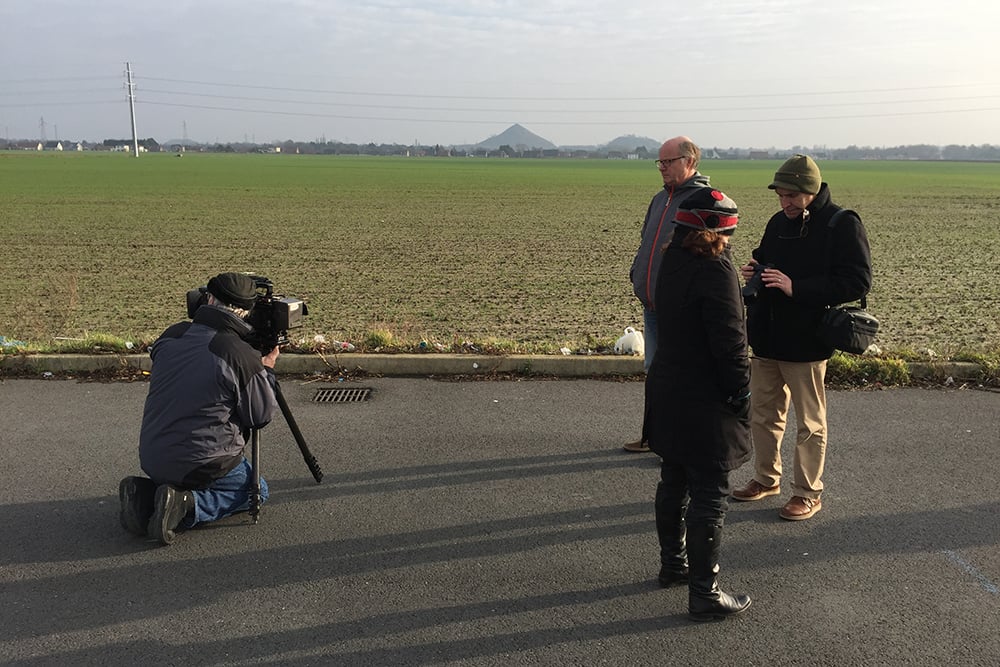
After the Chinese Buffet
We were done in northern France. We had said goodbye to our architects and were packed up for our drive north to Amsterdam. We needed to eat lunch, but because it was Sunday, everything in town was shuttered. So we drove to the mall on the edge of town and found Le Royal Ming, a Chinese buffet just like Chinese buffets anywhere, except the menu was in French and they had items you’d be hard pressed to find in a Chinese buffet in the States, like french fries and ice cream. We had our lunch, and as we headed to the van, saw those two beauties in the distance on the horizon. They are terrils, manmade hills of coal-mining leftovers, remnants of hundreds of years of digging in the earth to extract coal. We knew we had to get some photography of them, or we would have failed to fully represent the “industrial archeology of the region,” as UNESCO’s Francesco Bandarin called it. Tim had to put his camera very low to the ground to avoid the telephone wires. Everyone patiently stood by as the wind blew, and despite the sun – the only sun we saw the entire trip – it remained cold. Ironically, Tim thought he hadn’t got the shot – he thought he’d failed to roll. He didn’t realize it was there until we were back in the States.
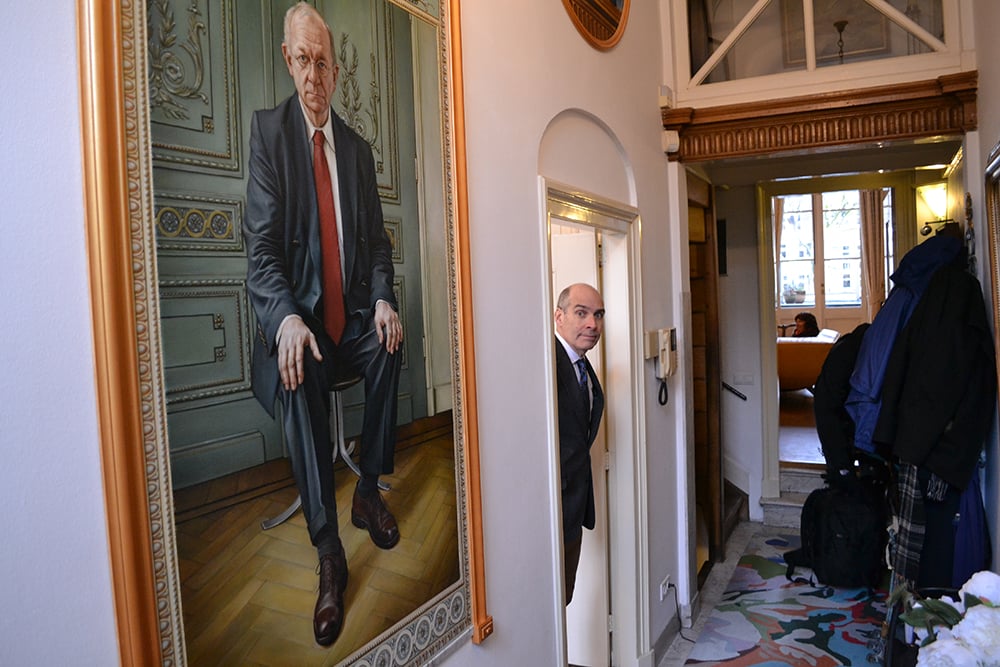
Geoffrey at Frank’s Place
Our host Geoffrey Baer peeks out of the dining room in Frank Bijdenijk’s Amsterdam canal house. Frank is one of Amsterdam’s most important developers of social housing, according to Marc Breitman. He hired Marc and Nada to design Amsterdam’s mosque. Frank’s house was a marvel, filled with art, including a set of fresco-like paintings of his family along the entry hall. You can see the one of Frank on the left side of the photo. When you work with Geoffrey Baer, you are teamed with a person of boundless curiosity and enthusiasm for whatever we’re doing, especially if it involves travel. Unlike me, he loves airplanes, he loves flying, and he enjoys the adventure of all the dislocation that travel entails. He also contributes to and helps shape the story. He brings decades of experience, and like many who have been doing this work for so many years, he has skills that I doubt even he knows he has. One of them is quickly walking into a new relationship and establishing the rapport needed to pull off an effective interview. Another is to keep track of what he was wearing in each shot, where he held his hands, whether his glasses were on or off. You might think these are small things to understand; I assure you they are not. He is also great at reworking a voiceover script into something tight, logical, and entertaining.
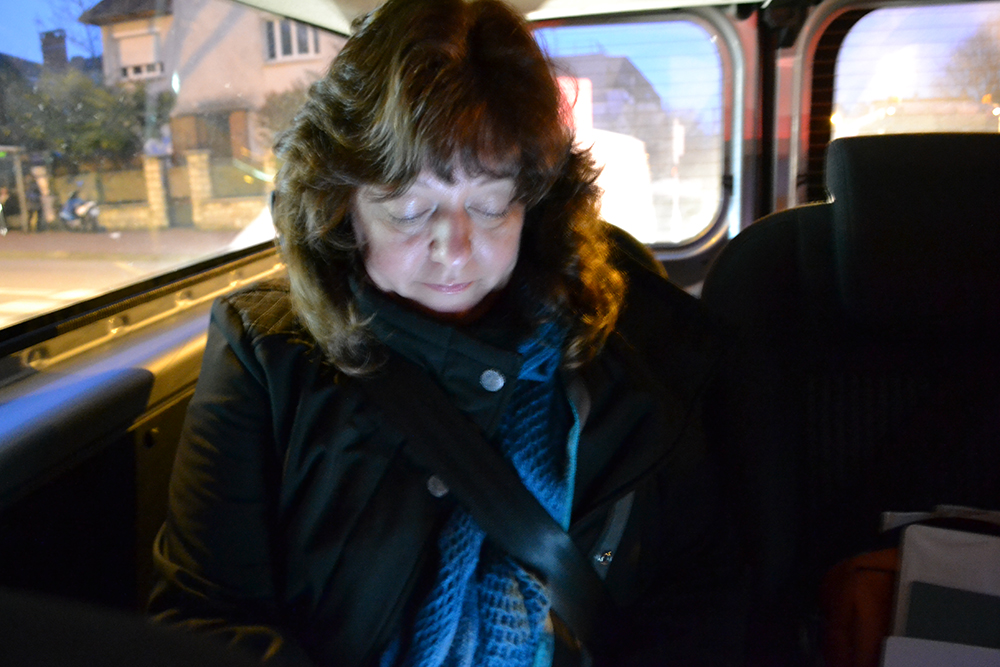
Liz Reeves
This is Liz, early morning in the van. Headed somewhere, probably in coal country. Liz is my co-writer and co-producer, formerly assistant producer. We have worked together since 2012, and in that time we have found ways to support the project and mold the vision together. After a couple of years of learning the basics of making a show like this, from the planning of shoots to the hunt for archival material, Liz was ready to take on more. First, she acted as a co-writer, and this time, a co-producer. She and I shared the basic conception of the show, shared the research, and both had pre-production conversations with the architects. She also shared the load of the first round of editing, which is something that I’ve done alone in the past. As a result, this was one of the most civilized and well-ordered shooting and post-production processes I’ve ever experienced. I had no late nights or weekend marathons of work, and we finished the show in record time. We make a good team.
Victor
Victor was our French driver/fixer. He’s covering his face because we were joking that his outfit was very much like that of a Red Latvian rifleman, a group of Soviet revolutionary fighters whose ranks included important artists, like Gustav Klutsis. And, probably a lot like Klutsis, Victor is a smart, creative, hard-working, fun guy. He is carrying the video monitor around his neck, making it easier for me as we race through a number of walking shots in Bruay-la-Bussiere with our architects and Geoffrey. They are visible in the background. Victor knew his way around, and skillfully took us to where we needed to go. He could manage the complicated streets of St. Germain-des-Prés, where Marc and Nada live, and the district’s notoriously picky parking police. His English was excellent. He loved that I love French cinema, going back to the silent era, with stops for Jean Gabin and Georges Franju along the way. But it was his love of jazz that stood out for me. Every night on the way back to the hotel, he’d tune in to Paris’s jazz station and we’d be treated to the greatest mix of jazz, from vocalists from the ‘40s, to European modal artists from the ‘70s, to blues-heavy traditionalists of the ‘30s, to bebop masters. And contemporary jazz artists, too. The diversity was shocking. It was unlike any jazz station I’d ever heard. And Victor made sure it was going on every night.

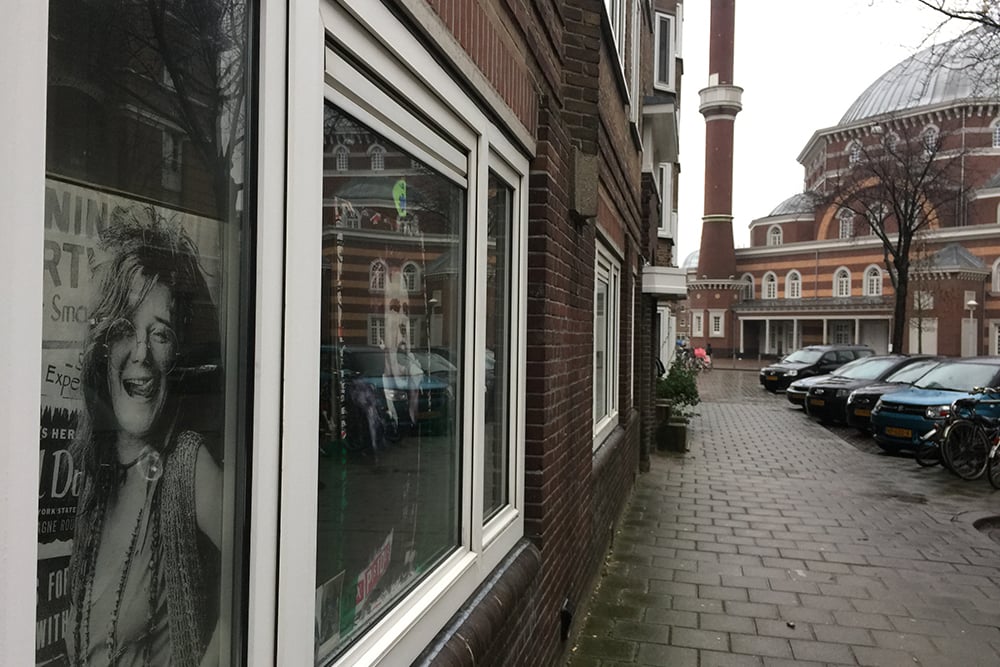
The Most Beautiful Mosque in the Western World
Amsterdam is a town known for its canals, bicycle riders, and open attitude to many things heavily policed elsewhere in the world, like pot and prostitution. They also have a fairly new mosque, and at this point in Holland’s history, there are complicated feelings around it. The mosque’s existence has a long gestation period, and there are marvelous documentaries online that explore how it came to be. I recommend this online interactive documentary, and Al Jazeera’s piece, which gives a more naked form to the debate. Marc and Nada’s designs, for the mosque and the surrounding apartment complex, are rich and subtle. In particular, the apartment complex does wonderful things to break up what otherwise might be a very repetitive and flat façade. Here I have Janis Joplin and Johnny Rotten in the foreground, posted in the window of an apartment a short distance away. West meets the Middle East.
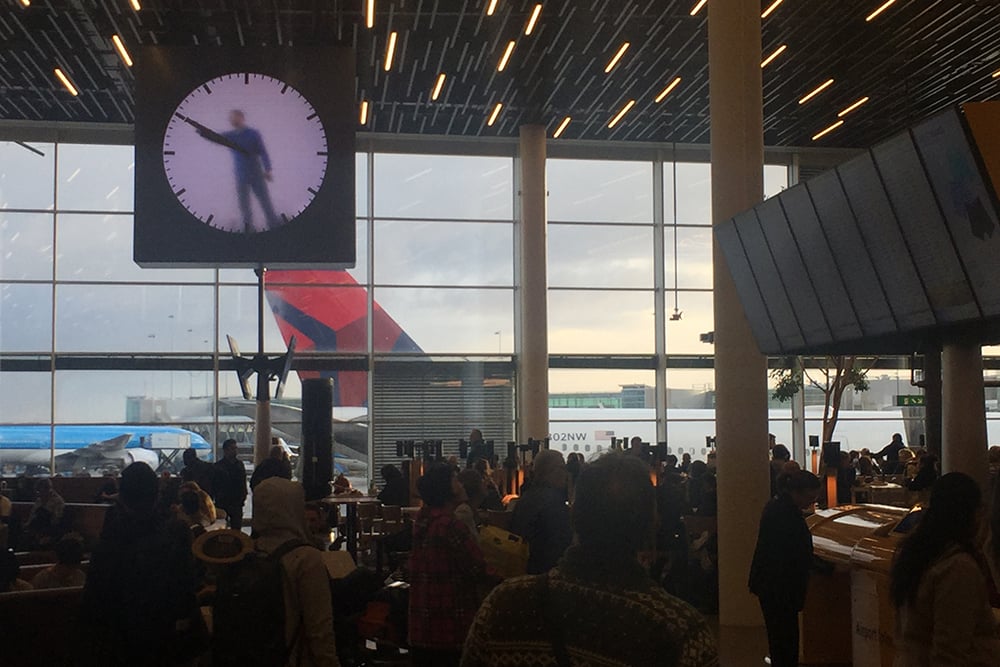
Flying
I have a very nice job. Sometimes I travel to Paris and Amsterdam, and visit places I might otherwise never see, like the coal country of Nord Pas-de-Calais. It’s just getting there that I hate. I dread it. The long flight, the time zone changes, and the jet lag; the fear of leg cramps, the humiliating journey through security; it goes on and on. But airports can sometimes surprise you with delights. In Amsterdam’s airport, Schiphol, there is a clock made by an artist. It appears that there is a man standing inside the clock painting the hand of the clock in, telling us the time. Of course there isn’t a man in the clock – it’s a projection. But it looks like there is. And sometimes that’s enough joy to make it worthwhile.
Crossing the Top of the World
While flying back to Chicago, we looked out the window and saw this, and realized it could only be Greenland. This is more astonishing than practically anything else we saw or did. I have probably flown over Greenland before, but it would have been the middle of the night. As we gaped and snapped pictures, the stewardess came to tell us that we could get a better view from their mid-section galley, and so we followed her. We found Geoffrey, equally agog, taking pictures. It was one of the great small-world, huge-world sights – all that white snow and a form I’ve known since childhood from maps, misshapen by the perspective distortions that come with trying to represent a three-dimensional sphere two-dimensionally. Just below us.
